The Southwest Culture Area is a culturally diverse area. Geographically it covers all of Arizona and New Mexico and includes parts of Colorado, Nevada, Utah, and Texas as well as parts of the Mexican states of Sonora and Chihuahua. Much of this area is semi-arid; part of it is true desert (southern Arizona); and part of it has upland and mountain ranges which support conifers.
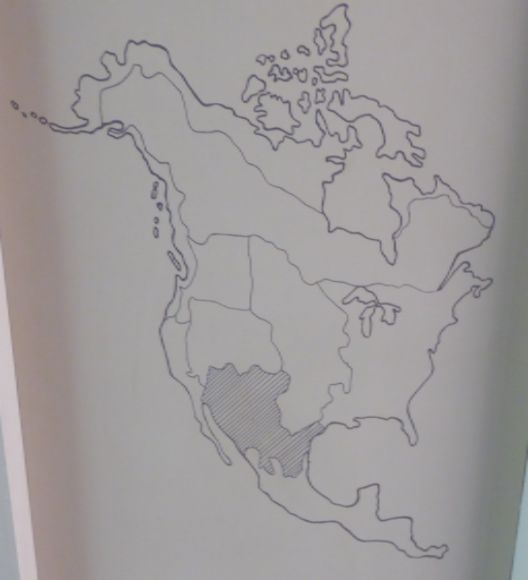 The shaded area on the map above shows the Southwest culture area.
The shaded area on the map above shows the Southwest culture area.
In her book Encyclopedia of American Indian Costume. Josephine Paterek describes the area this way:
“The Southwest is an arid, inhospitable land, but one of great diversity where some mountains are as high as 12,000 feet and where deserts may be barely above sea level, creating a great variation in temperature. It is a spectacular land of towering, overhanging cliffs, great mesas as flat as tables, and strange rock formations, all in violent hues of red, pink, orange, and yellow, splotched and streaked.”
Like peoples throughout the world, the Native peoples of the American Southwest enhanced their personal appearance by wearing jewelry. Today, Southwestern jewelry and beadwork are often considered art and displayed in many art museums around the world. Some of the jewelry and beadwork by Southwestern Native American artists displayed at the Maryhill Museum near Goldendale, Washington, is shown below.
Jewelry
The Southwestern tribes are well-known for their jewelry. In her essay on jewelry in Dimensions of Native America: The Contact Zone, Caroline Klarr writes:
“For thousands of years native peoples of the southwestern United States have produced items for personal adornment made from shell, turquoise, and other semi-precious stones, mined locally or obtained through trade.”
Southwestern jewelry serves not only the function of personal adornment for tribal members, but is both an item for the tourist trade and for the art market.
With regard to Pueblo jewelry, Ruth Underhill, in her book Work a Day Life of the Pueblos, reports:
“It was the men who wore most jewelry, not the women.”
Turquoise—often called the “sky stone” because of its color—is associated with rain, growth, and fertility. Caroline Klarr writes:
“Turquoise has been worn for personal adornment for hundreds, if not thousands, of years.”
Long before the European invasion, Indian people in the Southwest mined turquoise using stone hammers and antler picks. One of the prehistoric mines near Cerrillos, New Mexico, extends two hundred feet underground and in some places, the mine is three hundred feet wide. Turquoise mined in New Mexico was traded far south into Mexico.
In the tenth century, the workshops in the pueblos in Chaco Canyon, New Mexico, were converting large quantities of turquoise into beads and pendants which were traded into Mesoamerica.
In her book North American Indian Jewelry and Adornment from Prehistory to Present, Lois Dubin writes:
“Turquoise is the central ingredient in Navajo prayer offerings for rain. A Navajo hunter provides turquoise to the deer as a sign of respect so that the deer may allow its life to be taken. Similarly, the Navajo give turquoise to each other as an expression of friendship and kinship.”
Another common item used in southwestern jewelry is shell. Shell is not native to the area and has to be obtained through trade.
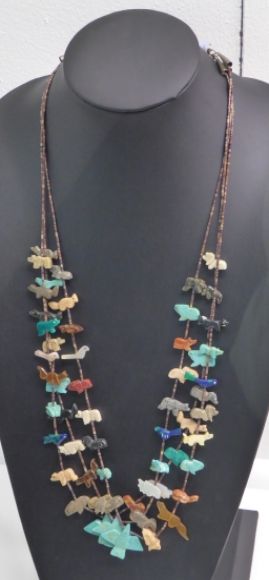 Shown above are Zuni-style fetish necklaces made about 2010 by unknown artists (Zuni or Navajo).
Shown above are Zuni-style fetish necklaces made about 2010 by unknown artists (Zuni or Navajo).
The use of fetishes among the people of Zuni is an ancient custom. In his book An Introduction to Southwestern Indian Arts & Crafts, Tom Bahti writes:
“Any object may be used as a fetish; arrow points, concretions, shells, or plants. A spirit is believed to dwell in the object which can give assistance, in the form of supernatural power, to its owner.”
Tom Bahti also writes:
“The most common fetishes seen on the market are the ones used for hunting. They may be carved from shell, stone or antler.”
Norman Feder, in his book American Indian Art, writes:
“The animal fetishes made of hard stone probably represent the highest development of stone carving among Indians in historic times.”
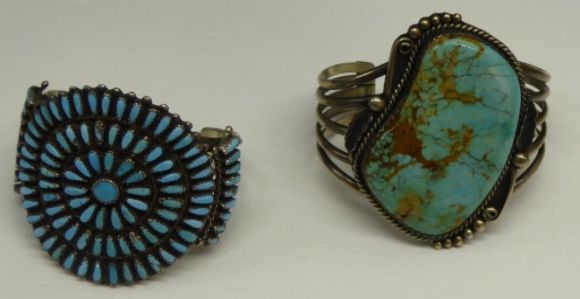 Shown above are Navajo bracelets made about 1990 by unknown artists.
Shown above are Navajo bracelets made about 1990 by unknown artists.
In his book An Introduction to Southwestern Indian Arts & Crafts, Tom Bahti writes:
“…typical Navajo work is noted for its massive quality and simplicity of design. Turquoise sets are used primarily to enhance the beauty of the silver.”
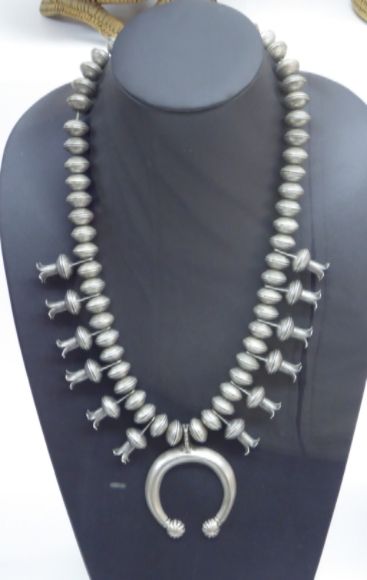 Shown above is a Navajo squash blossom necklace made about 1950 by an unknown artist. Roosevelt dimes were used to make the large silver beads.
Shown above is a Navajo squash blossom necklace made about 1950 by an unknown artist. Roosevelt dimes were used to make the large silver beads.
In his book An Introduction to Southwestern Indian Arts & Crafts, Tom Bahti writes:
“The widely circulated stories which describe the naja and the squash blossom necklace as symbols of fertility are products of the ‘whiteman’ imagination and have no basis in Indian legends, beliefs, or customs.”
In her book North American Indian Jewelry from Prehistory to Present, Lois Dubin writes:
“Introduced to the Navajo at the turn of the century, the flowerlike pendant form known as the squash blossom is actually a symbolic representation of the Spanish-Mexico pomegranate. Spanish colonial gentlemen wore silver versions of pomegranates (a motif of Granada, Spain) on their shirts, capes, and trousers.”
In the 1880s and 1890s, Navajo silversmiths were copying this motif to create what is now known as the squash blossom necklace.
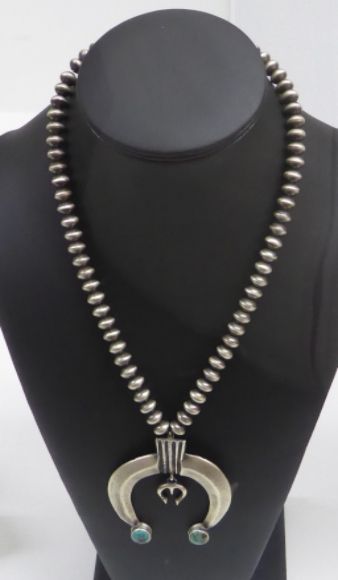 Shown above is a Navajo sandcast Naja pendant made in 2016 by Savannah Morgan (Navajo).
Shown above is a Navajo sandcast Naja pendant made in 2016 by Savannah Morgan (Navajo).
The Naja (pronounced na-zha) is an ornament which the Spanish had originally copied from the North African Moors (i.e. Muslims) who used it to ward off the evil eye.
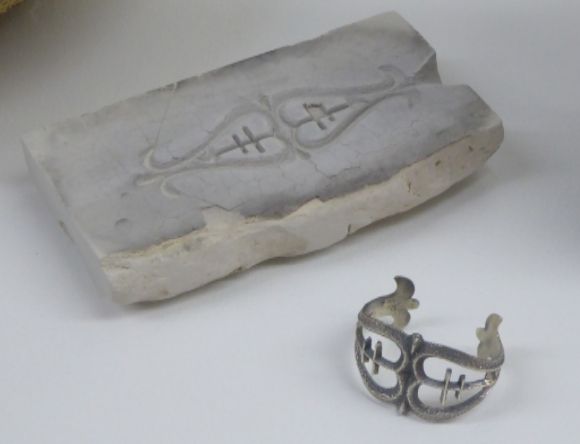 Shown above is a tufa-cast silver bracelet and tufa mold made in 2016 by Gary Custer (Navajo).
Shown above is a tufa-cast silver bracelet and tufa mold made in 2016 by Gary Custer (Navajo).
In his book An Introduction to Southwestern Indian Arts & Crafts, Tom Bahti writes:
“Sandcasting makes use of a mold of soft volcanic pumice or tufa. A piece of tufa is ground to a smooth surface and the design carved in it with a knife or file.”
A flat slab of pumice is placed on top of the mold and wired in place. The melted silver is then poured in.
Tom Bahti writes:
“Sandcasting is one of the most difficult silverworking techniques. Relatively few silversmiths are skilled in this work.”
Beadwork
Glass beads were first introduced to the Southwestern Indian artists in 1540 by the Spanish Coronado expedition.
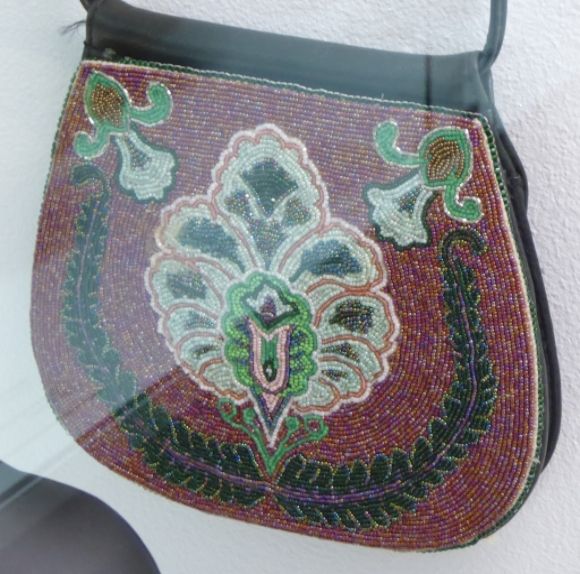 Shown above is a purse with a beaded flap made about 2012 by Paul LaRose (White Mesa Ute).
Shown above is a purse with a beaded flap made about 2012 by Paul LaRose (White Mesa Ute).  Shown above is a beaded pendant made about 2012 by an unknown Ute artist.
Shown above is a beaded pendant made about 2012 by an unknown Ute artist. 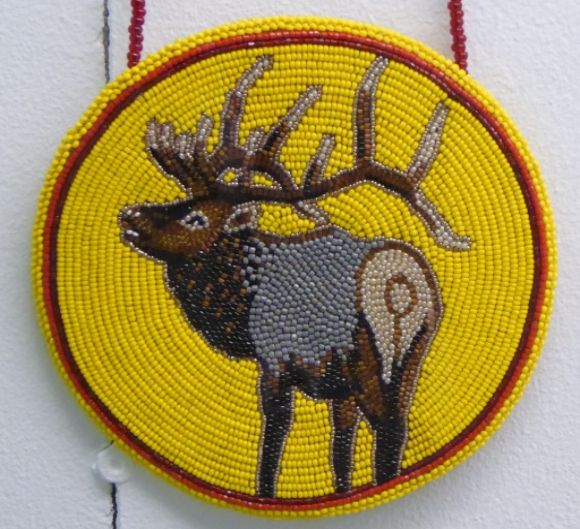 Shown above is a beaded pendant made about 2012 by an unknown Ute artist.
Shown above is a beaded pendant made about 2012 by an unknown Ute artist. 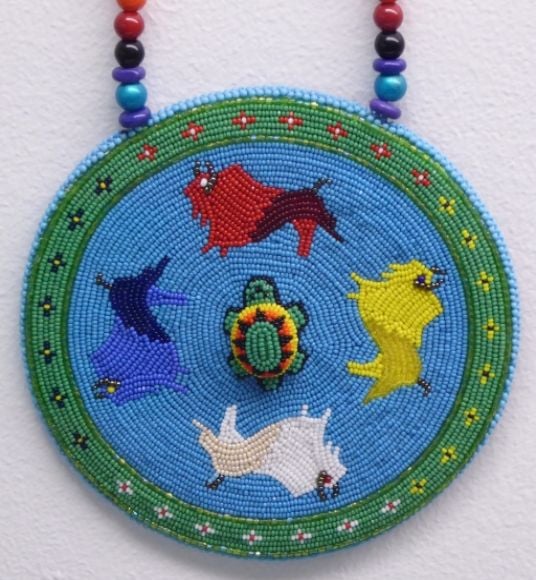 Shown above is a beaded pendant made in 2016 by Valerie Willie (Navajo).
Shown above is a beaded pendant made in 2016 by Valerie Willie (Navajo).

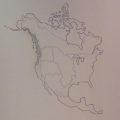
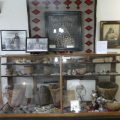

Leave a Reply